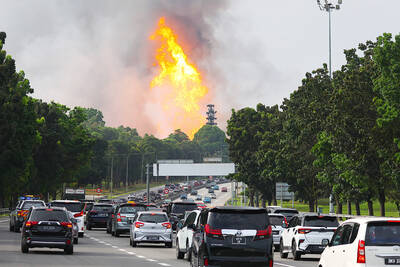"I am one of the last left, you know," Madame Han tells onlookers. Han is 84 years old, and has tiny bound feet. We are in a shoemaker's in Shanghai and she waits patiently as the shoemaker's assistant takes her measurements.
"Strange to think it was an erotic thing," the boss Li Wanhong says to me as we watch. "To us, the smell of rotting flesh would be unbearable. But back then men wrote poems about the rich smell."
Li is the 45-year-old owner of the last workshop in China producing tiny cloth shoes for elderly women whose feet were bound before the practice finally died out in the 1920s. The youngest of her customers is 80 years old, the oldest 101.

PHOTO: AFP
Li's staff of five work from a front room in an apartment in a residential area of Shanghai's Pudong district, sitting among piles of boxes ready to ship. Mainly, the workshop produces handmade slippers in adult sizes -- but these former employees of the state-owned Shanghai shoemaking factory are also accidental heirs of a 1,000-year-old tradition.
"We don't really aim to make money from the miniature shoes," Li said. "But somebody has to do it."
The origins of footbinding are controversial. Tradition places the birth of the practice in the imperial court of the late 10th century -- aristocratic women, the story goes, envied the graceful small feet of a particularly beautiful palace dancer, giving rise to a fad which spread to towns and villages across the country. This was the story mothers passed on to their daughters as they tightened the bandages.
Modern academics point out however that a small foot featured in the Chinese conception of beauty long before the 10th century. The final process probably evolved from less vicious techniques, as families experimented with ever tighter binds in the quest for the smallest foot in town. And there may still have been an element of royal endorsement; the practice may have been adopted at the imperial court to prevent concubines escaping the harem. The castration of the palace eunuchs certainly demonstrates an acceptance of bodily mutilation to serve imperial ends.
There is much here we don't know; what we do know is that the process of binding a foot was agonizing -- so painful that by some estimates one girl in 10 died of shock in the first few days.
Beginning when the girl was perhaps aged six, the mother would wrap a 3m bandage around her daughter's toes, forcing all but the big toe to fold back underneath the sole. This would be tightened over time, causing constant discomfort -- and because it restricted the blood supply to the extremities there was a good chance it would cause necrosis of the foot, as in cases of frostbite.
"Sometimes this would result in an auto amputation," said Adam McGeoch is a medical researcher based at Cambridge University. "The toe would slough off."
"Certainly in the early stages, while necrosis was taking place, there would be a strong smell," McGeoch said. "Not so much once the foot was dead. If the adult foot had a smell, probably it was bacteria, trapped in the folds between the remains of the bent-over toes and what would normally be the sole of the foot."
It is difficult to estimate the number of women with bound feet who are still alive today. In the modern cities, where the practice died out earliest, numbers are very few; Li Wanhong knows of only 80 in the greater Shanghai area. Larger numbers are found in certain rural areas, and in 2001, Chinese Television estimated that nationwide there may still have been a million women alive who had experienced binding in some form.
Yang Qiqi is a 23-year-old graduate from Nankai University; fashionable and modern-thinking, she is an acclaimed violinist.
Yang and her mother escaped footbinding; her grandmother Wang Yuzhen, along with perhaps the preceding 35 female generations of her family, did not.
"My grandmother was born in the countryside around Tianjin in 1912. Her feet were bound from the age of six," Yang said.
The family were wheat farmers; they were dirt poor but hoped their daughter would bring a good dowry. And although the government had outlawed footbinding in 1911, it was still very much a part of rural life.
"She said the pain as a child, for those first two years, was almost too much to bear," Yang said. "But she didn't suffer so much in old age. She walked a little slowly, but that was all. She later confessed to us that she used to secretly unwrap the bandages in bed. Her feet weren't so badly affected as a result."
For many women among Wang's 35 preceding generations, however, suffering probably continued in their adult lives. For those with the most severely compressed feet, the body weight when walking was borne by the heel; this jarred the spine and caused debilitating lower back problems in later life. Some communities bound the feet loosely so that women could help with farm work -- but where economic conditions permitted, women spent mostly static lives in their rooms, carried from boudoir to tea pavilion, to lily pond and back again. This very inactivity brought medical problems of its own, with the atrophy of under-used muscles.
The significance of the practice operates on several levels. A bound foot, particularly when showcased in a slipper, was considered attractive in itself. The disfigured female foot became the centerpiece of foreplay; men would caress a lover's slippered foot, or drink Chinese brandy from her shoe. To the women themselves, bound feet were a mark of femininity; and undergoing (and surviving) the binding process served as a female rite of passage.
A girl's carefully crushed feet also communicated important messages to society at large. It demonstrated that a particular family did not require its women to work in the fields. It showed acceptance of traditional Confucian ideas of a woman's passive social role; and the very act of enduring the pain -- for the lucky majority whom the pain did not kill -- demonstrated patience and selflessness, qualities attractive to traditionally minded husbands.
For perversely, the practice was a kind of leveller -- a girl's prospects were not automatically determined by what nature gave her, but by her willingness to undertake self-cultivation as perceived.
Today, in the malls and clubs of 21st-century Shanghai, such attitudes seem more than a little antique. Modern women, when they think about footbinding at all, see it merely as a repugnant curiosity -- perhaps a fading recollection from childhood, of the old grandmother hobbling to the water store in her blue Maoist uniform, like memories of nights spent on brick beds and water buffalo on the edge of town, another relic of the days before capitalism roared in and turned the country on its head.
In some ways this is evidence of how the status of women in China has been transformed in the past 100 years. Concubinage has been abolished, the purchasing of brides severely curtailed and, at least in the biggest cities, the birth of a female child is no longer a disappointment. The opportunities for women to work have greatly expanded; while women may not figure prominently in senior government there are significant female presences in other professions.
This is not to say that old sexisms have been eradicated. This is a society, after all, where successful middle-aged men routinely date girls in their early 20s. It's accepted that men who can afford to will support a mistress.
Sophie Li, 29, works as a personal assistant (PA) for a European multinational company.
"I think in China there is still a greater degree of objectification of women than in countries like Britain," she said. "Looks are always important when you apply for a job here -- sometimes the most important thing of all."
Companies routinely refer to desired physical appearance in job advertisements. One British firm operating in Shanghai recently placed a job ad for a new PA to the managing director.
"Would suit former model," potential applicants were advised.
In the past few years, beauty contests, after years of Communist disapproval, have become fashionable. Next year's Miss World competition will be held in Hainan Island for the third year in a row.
At some levels of Chinese society, women are still willing to endure pain to conform to an ideal of beauty. Cosmetic surgery outfits are now big business -- in 2003, for instance, the Ninth People's hospital in Shanghai performed an industrious 70 cosmetic operations a day. A particular regional favorite is eyelid reconstruction, a 30-minute operation where an extra crease is sewn into the eyelid above the eye, giving a more Western countenance.
Nowadays women are choosing cosmetic surgery for themselves, whereas no six-year-old ever asked to have her feet bound. But when, as in November 2003, a newspaper runs a competition to find "the ugliest girl in Shanghai," it does seem that China's feminist revolution has yet to run its course. The prize, inevitably, was cosmetic surgery; the winner, a girl from the countryside called Zhang Di,was thrilled, and giddily informed reporters than finally, at the age of 26, she might catch a man.
"Every girl wants to find a good man," Han said. "You mustn't seem unattractive. That's why we had to bind our feet. Some things don't change."
On the work bench, her tiny slipper is now taking shape. It is 16cm from heel to toe, and it would hurt an eight-year-old child.

A fire caused by a burst gas pipe yesterday spread to several homes and sent a fireball soaring into the sky outside Malaysia’s largest city, injuring more than 100 people. The towering inferno near a gas station in Putra Heights outside Kuala Lumpur was visible for kilometers and lasted for several hours. It happened during a public holiday as Muslims, who are the majority in Malaysia, celebrate the second day of Eid al-Fitr. National oil company Petronas said the fire started at one of its gas pipelines at 8:10am and the affected pipeline was later isolated. Disaster management officials said shutting the

US Vice President J.D. Vance on Friday accused Denmark of not having done enough to protect Greenland, when he visited the strategically placed and resource-rich Danish territory coveted by US President Donald Trump. Vance made his comment during a trip to the Pituffik Space Base in northwestern Greenland, a visit viewed by Copenhagen and Nuuk as a provocation. “Our message to Denmark is very simple: You have not done a good job by the people of Greenland,” Vance told a news conference. “You have under-invested in the people of Greenland, and you have under-invested in the security architecture of this

Japan unveiled a plan on Thursday to evacuate around 120,000 residents and tourists from its southern islets near Taiwan within six days in the event of an “emergency”. The plan was put together as “the security situation surrounding our nation grows severe” and with an “emergency” in mind, the government’s crisis management office said. Exactly what that emergency might be was left unspecified in the plan but it envisages the evacuation of around 120,000 people in five Japanese islets close to Taiwan. China claims Taiwan as part of its territory and has stepped up military pressure in recent years, including

UNREST: The authorities in Turkey arrested 13 Turkish journalists in five days, deported a BBC correspondent and on Thursday arrested a reporter from Sweden Waving flags and chanting slogans, many hundreds of thousands of anti-government demonstrators on Saturday rallied in Istanbul, Turkey, in defence of democracy after the arrest of Istanbul Mayor Ekrem Imamoglu which sparked Turkey’s worst street unrest in more than a decade. Under a cloudless blue sky, vast crowds gathered in Maltepe on the Asian side of Turkey’s biggest city on the eve of the Eid al-Fitr celebration which started yesterday, marking the end of Ramadan. Ozgur Ozel, chairman of the main opposition Republican People’s Party (CHP), which organized the rally, said there were 2.2 million people in the crowd, but